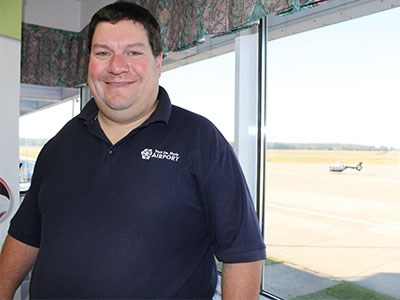Over the next five to 10 years, the Sault Ste. Marie Airport is projected to develop a business park, complete upgrades to its passenger terminal, and continue to grow passenger numbers, according to a report prepared for the airport’s development commission.
Retained by the commission last year, consultant Aviotec prepared the business and land use master plan to provide the commission with a guideline on how it can move forward with changes at the airport that reflect developments in the aviation industry.
“It’s a 20-year master plan, but it’s focused on the next five to 10 years,” airport CEO Terry Bos said. “Over time, things can change. It’s really hard to tell where things are going to go beyond the short term.”
Statistics show passenger numbers continue to grow. Whereas they sat at about 124,000 a few years ago, by the end of August, they had reached the 200,000 mark, which had been a goal of the corporation.
“We’ve been pushing for 200,000 for a long time and, according to the statistics that are in that document, we should be looking at the 200,000 level in the next two or three years which is really exciting,” Bos said. “It shows some strong growth continuing on past that.”
Bos said that’s largely attributable to the arrival of competition from Porter Airlines in 2011, which brought fares down and encouraged more people to fly out of the Sault — on Porter and the Sault’s other two airlines: Air Canada and Bearskin — instead of flying out of the U.S. or driving to their destinations.
“When our fares were higher, a lot of people went to the U.S. and now they’re used to flying out of the U.S., but our pricing has become a lot more competitive,” Bos said. “On the fare value, we’re probably right there. The problem is Canadian taxes on aviation are still significantly higher than the U.S. so the overall ticket price is still higher than it is in the U.S.”
In expanding passenger service, the airport is looking at more charter flights south, as well as some to Europe, which statistics show is a destination for a large contingent of passengers. Bos said passengers could potentially fly into a central destination in Europe before continuing on to their final destination.
The commission also has its eye on continuing the expansion of its business park, whose anchor tenant is J.D. Aero. Bos said the airport has 50,000 square metres of property in that area that can be expanded, in addition to another 47,000 square metres of development laid out with nothing on it yet, but which would be ideal for smaller manufacturing-type industries.
Some of the land that’s surplus to the airport’s activities may be put on the auction block to generate some revenue, which could be reinvested into the airport’s development, Bos added.
There could also be an opportunity to establish a training centre of excellence, building on the foundation set by Sault College’s aviation program, the Sault Aviation training school, and the Ministry of Natural Resources, which launched a new hangar to house its CL-415 training simulator last year.
“We have a good training mix,” Bos said. “We just have to nurture it and make it grow.”
Capital projects lined up for the facility include the further expansion of the terminal. With the increase in passenger numbers, the holding room is getting close to capacity, Bos said, so the airport plans to move the food and beverage area beyond the screening lines and enhance the washroom facilities to make wait times more comfortable.
The runways will also get some attention. In the next three to five years, the secondary runway, which is more than 50 years old, will be examined to determine if it needs upgrades. And while the main runway can meet the needs of the current market, an expansion by another 2,000 feet could be its future if the market demands it. If there is a hangar expansion, the commission would look at extending the runways and taxiways at the same time, Bos said.
“There’s a lot of exciting opportunities,” Bos said. “Obviously, they all cost money and we’ll have to be able to fund them, but if the passenger numbers stay strong and we can see synergies start to grow, that are developing in training and in maintenance, I think the opportunity will be there for us to look at whatever we really want to do.”




